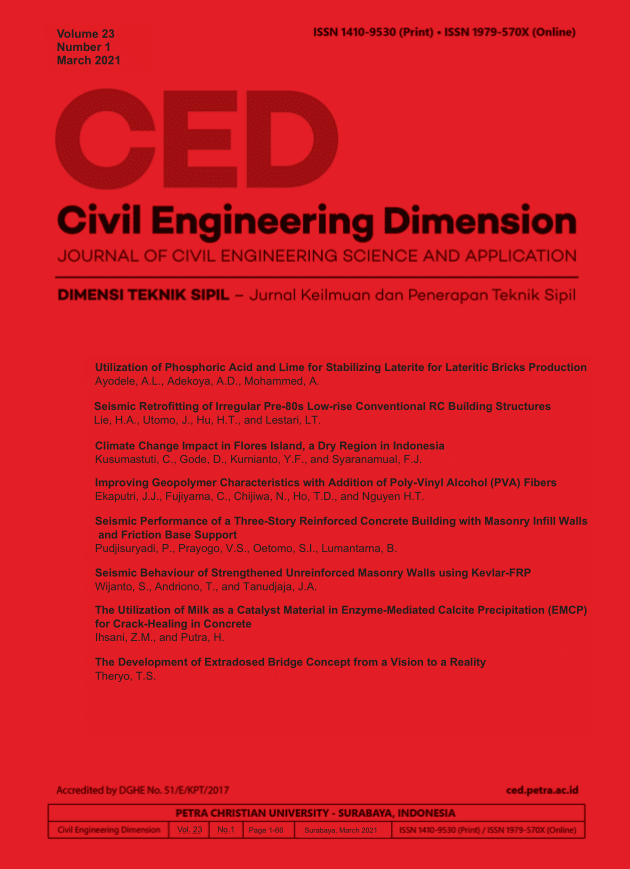Utilization of Phosphoric Acid and Lime for Stabilizing Laterite for Lateritic Bricks Production
DOI:
https://doi.org/10.9744/ced.23.1.1-8Keywords:
Phosphoric acid, Lateritic bricks, Hydrated lime, Compressive strength, Modulus of rupture, Dry density, pH.Abstract
This study investigates the use of phosphoric acid (H3PO4) and lime in stabilizing lateritic soil for lateritic bricks production. Varying percentages (0, 2, 4 and 6%) of 1 M H3PO4, 5% lime and their combinations were mixed with lateritic soil for stabilization purpose. Hollow bricks were produced from the different mixes. The bricks were cured for 7, 14 and 28 days under ambient air condition. The compressive strength (fc), bulk density (pb), dry density (pd) and water absorption rate were determined at each of the curing days while the modulus of rupture (fr) and pH were determined after 28 days. The results show a maximum fc of 0.93 N/mm2 and 0.87 N/mm2 were obtained at 5% and 4% H3PO4 stabilization. The maximum pb and pd of 15.2 kN/m3 and 14.9 kN/m3 respectively were obtained at 4% H3PO4 stabilization. The maximum fr of 0.2 N/mm2 was obtained at combined 4% H3PO4 and 5% lime stabilization while none of the bricks passed the water absorption test.
References
Baher, R., Benazzoug, M., & Kenai, S., ‘Performance of Cement - Stabilized Soil. Cement and Concrete Composites, 26(7), 2004, pp. 811 -820.
Mitchell, J.K. and Soga, K., Fundamentals of Soil Behavior’, Third edition. Wiley, New York, 2005.
Gidigasu, M.D., Mode of formation and geotechnical characteristics of laterite materials of Ghana in relation to soil forming factors. Engineering Geology. 6(2), 1972, pp. 79–150.
Townsend, F.C., Geotechnical characteristics of residual soils. Geotechnical Engineering. Proceeding of American society of Civil Engineers. 111, 1985, pp. 77-93.
Eisazadeh, A., Kassim, K, and Nur, H., Stabilisation of tropical kaolin soil with phosphoric acid and lime, Natural Hazards, 61(3), 2012, pp. 931-942.
Wright P. H and Dixon K. K (2004). ‗Highway Engineering ‘, 7th ed., John Wiley and Sons, New York.
Carroll, D. and Starkey, H. C., Reactivity of clay minerals with acids and alkalies, Clay and clay Minerals, 19, 1971, pp. 321–333.
Michaels, A.S., and Tausch, F.W., Jr., Phosphoric Acid Stabilization of Fine Grained Soils: Improvements with Secondary Additives. HRB Bull. 282, 1961, pp. 28-37.
Begum, R., Habib, A., and Begum, H.A., Bricks Stabilized with Cement and Natural Rubber Latex. International Journal of Emerging Science and Engineering (IJESE), 2(4), 2014, pp. 36-38.
Olajumoke, A.M., Olonade, K.A., Obaye, U.J., and Ishola, O.O., A Study of Some Engineering Properties of Coconut Shells Ash Stabilized Lateritic Bricks for Affordable Housing. In: Proceedings of the Faculty of Technology Conference on: Innovative Technologies for Socio-Economic Transformation in Developing Countries, Ile-Ife, Nigeria, 2011, pp. 89-95
Wahabi, M.A., Effects of Natural Rubber Latex in Stabilizing Bricks. Unpublished M.Sc. Thesis, Obafemi Awolowo University, Ile Ife, 2017, pp.55-60.
Bock-hyeng, C., Ofori-boadu, A.N., Yamb-bell, E., and Shofoluwe, M.A., Mechanical Properties of Sustainable Bricks Stabilized with Recycled Sugarcane Fiber Waste. International Journal of Engineering Research and Application, 6(9), 2016, pp. 50-59.
Ayodele, A.L., Oketope, O.M., and Olatunde, O.S., Effects of Sawdust Ash and Eggshell Ash on Selected Engineering Properties of Laterized Bricks for Low Cost Housing. Nigerian Journal of Technology (NIJOTECH), 38(2) 2019, pp. 278-282. https://doi.org/http://dx.doi.org/10.414/njt.v38i2.1
Medina, J., and Guida, H.N., Stabilization of lateritic soils with phosphoric acid, J Geotech Geol Eng 13, 1995, pp. 199–216.
Winterkorn H. F. (1962). ‘Introductory remarks, vol. 318. Highway Research Board Bulletin (Soil Stabilization with Phosphorous Compounds and Additives)’ Washington, DC, pp. 1–3.
Michaels, A.S., Williams, P.M., and Randolph, K.B., Acidic Phosphorus compounds as Soil Stabilizer, Industrial and Engineering Chemistry, 50(6), 1958, pp. 889-894. Retrieved from http://pubs.acs.org/doi/abs/10.1021/ie50582a032
ASTM C 67 - 02c. Standard Test Methods for Sampling and Testing Brick and Structural Clay Tile. ASTM International, West Conshocken, PA, 2001.
Das, M.B., Principles of Geotechnical Engineering, Seventh edition, Cengage Learning, Stamford, 2006.
Lyons, J.W., and McEwan, G.J., Use of phosphoric acid in soil stabilization, Highway Research Board Bulletin, 282, 1961, pp. 4–14.
Sharma, V., Vinayak, H.K., and Marwaha, B.M., Enhancing sustainability of rural adobe houses of hills by addition of vernacular fiber reinforcement, International Journal of Sustainable Built Environment, 4(2), 2015, pp. 1-11.
NBRRI, Nigerian Building and Road Research Institute, Interlocking Blockmaking Machine. NBRRI Newsletter, 1(1), 2006, pp. 15-17.
Uniform Building Code. (1970). International Council of Building Officials.
Ghobadi, M.H., Abdilor, Y. and Babazadeh, R., Stabilization of clay soils using lime and effect of pH variations on shear strength parameters, Bull Eng Geol Environ 73, 2014, pp. 611-619. http://doi.org/10.1007/s10064-013-0563-7
Ayodele, A.L., and Agbede, O.A., Influence of Electrochemical Treatment on a Typical Laterite, Ground Improvement 171(2), 2017, pp. 103-111. http://doi.org/10.1680/jgrim.16.00030
Glendinning, S., and Rogers, C.D., Deep stabilization using lime, In: Rogers, C.D.F., Gle
Downloads
Published
How to Cite
Issue
Section
License
Authors who publish with this journal agree to the following terms:- Authors retain the copyright and publishing right, and grant the journal right of first publication with the work simultaneously licensed under a Creative Commons Attribution License that allows others to share the work with an acknowledgement of the work's authorship and initial publication in this journal.
- Authors are able to enter into separate, additional contractual arrangements for the non-exclusive distribution of the journal's published version of the work (e.g., post it to an institutional repository or publish it in a book), with an acknowledgement of its initial publication in this journal.
- Authors are permitted and encouraged to post their work online (e.g., in institutional repositories or on their website) followingthe publication of the article, as it can lead to productive exchanges, as well as earlier and greater citation of published work (See The Effect of Open Access).











